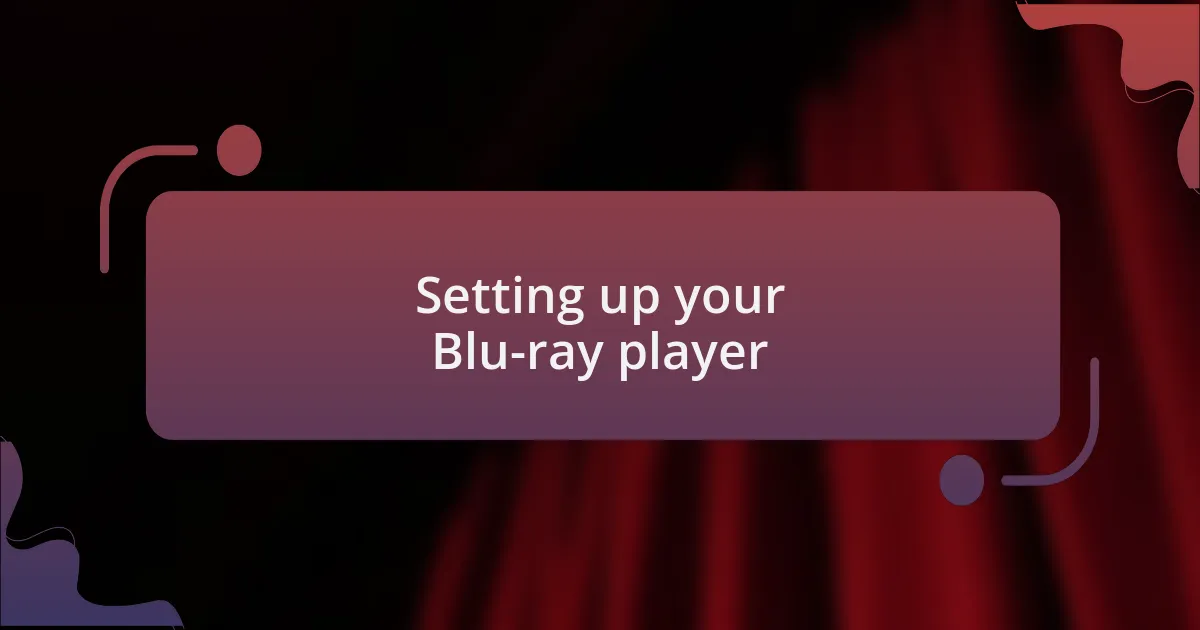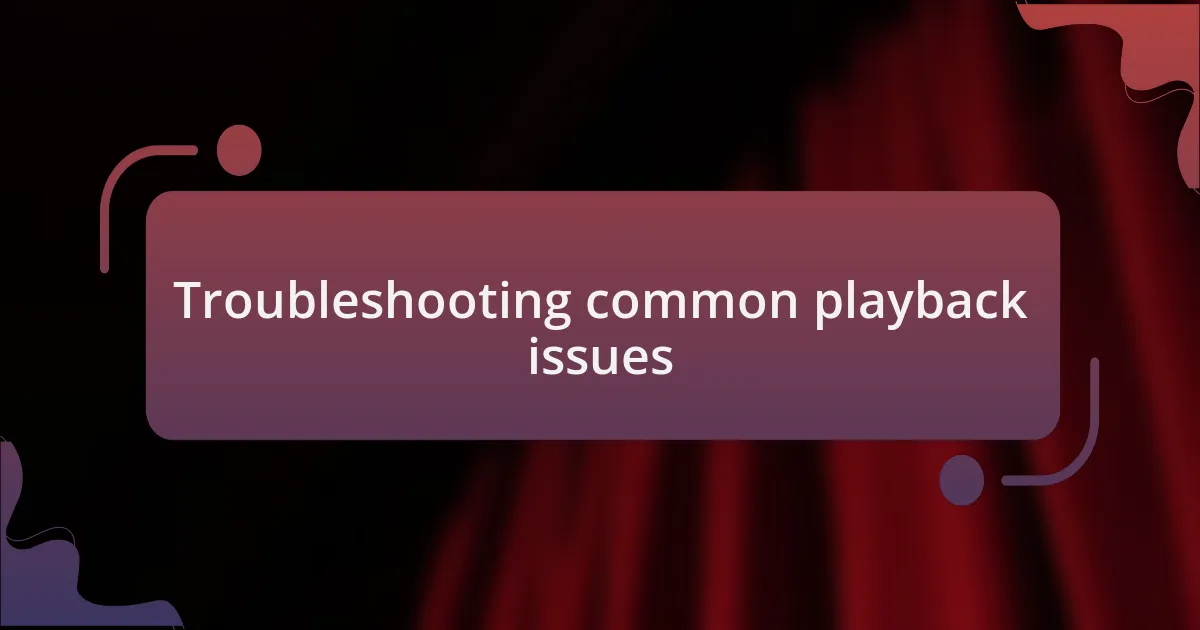Key takeaways:
- Blu-ray technology offers superior video and audio quality through multi-layered discs and advanced features like 4K resolution and interactive menus.
- Selecting the right Blu-ray player involves considering features like 4K support, connectivity options, and audio quality to enhance the viewing experience.
- Optimizing settings (audio, video, and firmware updates) can significantly improve playback quality and ensure a seamless viewing experience.
- Future trends in Blu-ray include 4K Ultra HD technology, enhanced interactive features, and potential cloud-based access to Blu-ray libraries.

Understanding Blu-ray technology
Blu-ray technology revolutionizes the way we view high-definition content by utilizing a blue-violet laser to read data. This laser has a shorter wavelength than traditional red lasers, allowing for closer track spacing on the disc. Remember that dazzling clarity and detail you experienced the first time you watched a Blu-ray? That’s the result of this advanced technology, enabling resolutions up to 1080p and beyond.
The structure of a Blu-ray disc is fascinating. It comprises multiple layers, which means it can hold significantly more data than a standard DVD. My first encounter with a Blu-ray disc left me in awe when I realized I could store entire seasons of a TV show or even multiple movies in stunning quality. Have you ever wondered how that much content fits? It’s this innovative layering that maximizes storage without compromising visual or audio quality.
Furthermore, Blu-ray players often include features like interactive menus and internet connectivity, which enhance the viewing experience. I remember being captivated by special features that allowed me to dive deeper into the filmmaking process. Isn’t it interesting how technology doesn’t just change what we watch but how we interact with our favorite films and shows? These advancements contribute to a richer, more engaging experience that keeps us returning for more.

Choosing the right Blu-ray player
When it comes to selecting the right Blu-ray player, the first thing I consider is the features that align with my viewing habits. Do I want a player that supports 4K Ultra HD? If you’ve experienced the jaw-dropping detail of 4K, then you know why this feature is a game-changer. There was a time when I had to upgrade my player just to enjoy the latest releases, and I realized that investing in a future-proof model was worth it for the long haul.
Another crucial factor is connectivity. I often seek out players that offer various options, like HDMI and Wi-Fi. The last thing I want is to get home with my new Blu-ray, only to find out I need additional cables or adapters. I remember the frustration of setting up my player and realizing I was missing just one cable when all I wanted was to enjoy my favorite films. So, I always recommend checking compatibility with your existing setup before making a purchase.
Lastly, I can’t stress enough the importance of audio quality. A cinematic experience is incomplete without rich sound. If you’ve ever watched a movie and felt like you were part of the action, you know how essential this is. After upgrading to a player that supports high-definition audio formats, I was blown away by how much depth it added to my viewing experience. It’s not just about seeing the picture—it’s feeling it, too.

Setting up your Blu-ray player
Setting up a Blu-ray player can feel a bit daunting at first, but I find that breaking it down into simple steps makes the process much smoother. The first thing I always do is check the power connections and ensure everything is plugged in correctly. There was one time I was excited to binge-watch a new release, only to realize my player wasn’t turning on because I had overlooked a loose power cord. It’s that moment of realization that can be frustrating, but it emphasizes the importance of checking the basics first.
Once I have the player plugged in, I connect it to my TV using an HDMI cable, which not only delivers high-quality video but also audio. I distinctly remember my first setup; I was amazed at how easy it was to achieve stunning picture quality with just this one cable. It makes such a difference when everything clicks together seamlessly. Have you ever experienced that feeling when the screen comes alive with vibrant colors?
After that, I dive into the settings menu to tailor the picture and audio options to my liking. I often play around with different settings until I find that perfect balance that suits my viewing environment. There was a time when I spent hours adjusting these settings, trying to capture that cinematic feel in my living room. I’d recommend taking the time to get familiar with these options—it can transform your viewing experience into something extraordinary.

Optimizing audio and video settings
When optimizing audio settings, I often start by adjusting the sound mode on my Blu-ray player. I remember watching a favorite film and being blown away by the difference when I switched from default stereo to surround sound. It felt like the action was unfolding right around me, making that movie night unforgettable. Have you ever noticed how the right audio can pull you deeper into the story?
Next up is video optimization. I typically crank the resolution settings to the highest possible output and fiddle with the color depth and contrast. I once spent an afternoon bingeing a series after tweaking these settings, and the colors popped with such vibrancy that I felt like I was seeing details I had missed before. It’s amazing how a little adjustment can completely change how I perceive a film.
Lastly, I often explore the advanced settings where I can enable features like 24p playback, which can make films look much more natural. I’ll never forget the first time I saw a movie in 24p; the experience was incredibly immersive and gave it a cinematic quality. Taking a few moments to explore these nuanced settings can truly elevate your home theater experience.

Troubleshooting common playback issues
There’s nothing quite as frustrating as settling in for a movie and encountering playback issues. I remember one evening, I was all set to watch a classic, but the disc wouldn’t load, leaving me staring at a menu screen that just wouldn’t budge. In my experience, simply cleaning the disc or ensuring it’s free from scratches can make all the difference. Have you ever found yourself stuck in a similar situation?
Occasionally, I’ve faced problems with subtitle synchronization, where the subtitles seemed to lag a good 30 seconds behind the dialogue. It felt like I was watching a poorly dubbed foreign film instead of the thrilling drama I had anticipated. I found that adjusting the subtitle settings in the player’s menu often resolved the issue. It’s fascinating how these little tweaks can turn frustration into seamless enjoyment.
Lastly, network issues can also hamper Blu-ray playback, especially with streaming content. I recall battling with buffering while trying to catch the latest release online. I learned that checking my Wi-Fi connection and resetting my router beforehand can dramatically improve playback quality. Have you tried those steps? Sometimes, simple adjustments yield the most satisfying results.

My personal optimization tips
When it comes to optimizing Blu-ray playback, I’ve discovered that adjusting the video settings often yields the best results. A particular film I was keen on watching looked washed out initially, and after some tinkering, I found the perfect balance between brightness and contrast. Have you ever fiddled with the settings and noticed a significant improvement? It’s worth experimenting to find what works best for your viewing environment.
One useful tip I’ve picked up along the way is to invest in a quality HDMI cable. Early on, I opted for a standard cable, but was frequently irritated by pixelation and dropouts. Switching to a high-speed HDMI cable not only enhanced the video quality but also eliminated those annoying playback interruptions. Have you considered how important the right cable can be for your Blu-ray experience? It truly makes a world of difference.
Lastly, keeping your Blu-ray player’s firmware updated is crucial. I recall a time when I was ready to immerse myself in a new release, only to find playback issues due to outdated software. Once I updated it, everything ran smoothly, allowing me to enjoy my movie without any hiccups. Do you regularly check for updates? This simple practice can save you from a lot of potential frustration and ensure your player performs at its best.

Future trends in Blu-ray playback
As I look to the future of Blu-ray playback, one of the most exciting trends I’ve noticed is the integration of 4K Ultra HD Blu-ray technology. The clarity that 4K provides is truly something to behold—it’s like experiencing my favorite films all over again, but with a depth that makes the visuals pop in ways I never thought possible. Have you ever watched a movie in 4K and felt like you were right there in the scene? It’s a game-changer for film enthusiasts.
Another trend that’s catching my attention is the potential for enhanced interactive features. I fondly remember watching a classic movie where I could choose alternate endings, which added a whole new layer to the viewing experience. Imagine how engaging it will be to have more dynamic content, such as director commentaries or behind-the-scenes features, easily accessible right on the disc. Who doesn’t appreciate being able to dive deeper into a film’s world?
I can’t overlook the shift towards cloud-based features as well. While I cherish the tactile sensation of handling physical discs, the idea of accessing my Blu-ray library from various devices is intriguing. This could mean that in the near future, I might just have the convenience to stream my favorite titles without having to dig through my collection. Have you thought about how digital integration could transform your viewing habits? It’s a thrilling prospect that combines the best of both worlds.